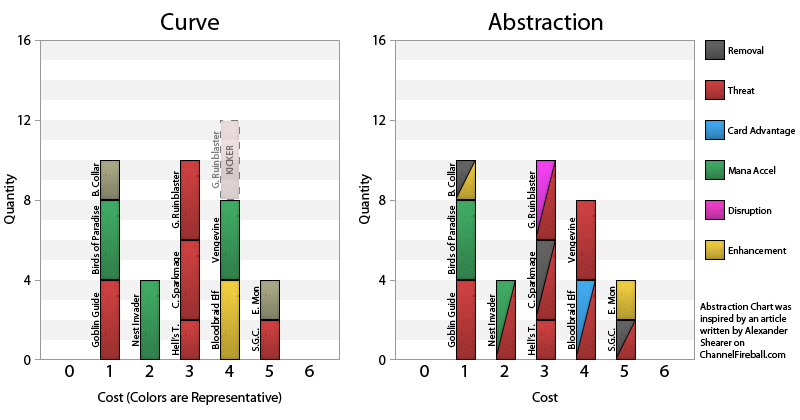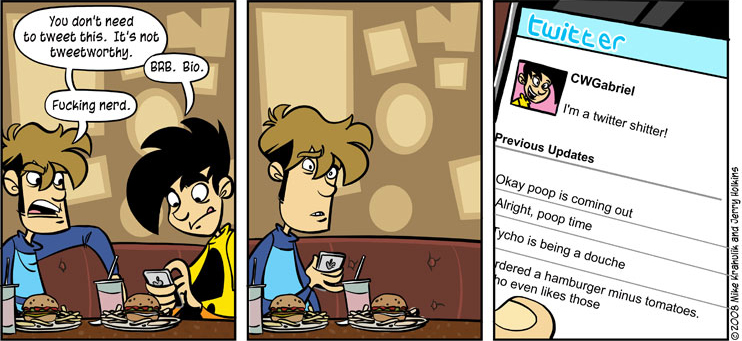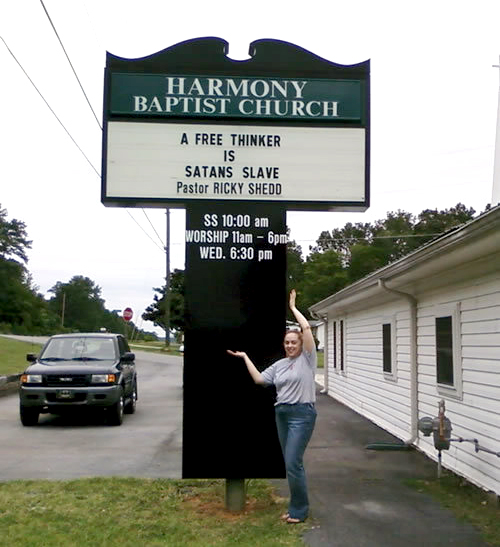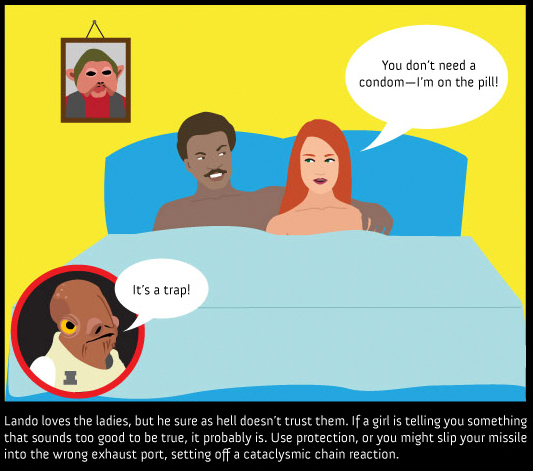I’ve been doing surprisingly well in Magic: The Gathering since my move to Maryland. I’ve placed (won a non-random prize) in every event I’ve participated in, and won two. Two of these events were Limited and the rest were Constructed.
R/G Vengeance
I haven’t seen my Standard deck posted exactly like this anywhere, so I was going to talk about it here.
Spells (36)
2x Eldrazi Monument
2x Siege-Gang Commander
4x Vengevine
4x Bloodbraid Elf
4x Goblin Ruinblaster
2x Hell’s Thunder
4x Cunning Sparkmage
4x Nest Invader
4x Goblin Guide
4x Birds of Paradise
2x Basilisk Collar
Lands (24)
3x Raging Ravine
4x Rootbound Crag
9x Forest
8x Mountain
Sideboard
4x Combust
4x Overgrown Battlement
3x Obstinate Baloth
4x Lightning Bolt

It’s VERY simple, but that only adds to its consistency. The intention of this deck is to create a game state where our aggression puts us in control of the board and how our opponent plays his hand. Nearly everything in our deck either hits them immediately, or ramps up our resources to hit them even harder next turn. They can never end their turn certain of what is coming their way next. This makes it hard for them to plan their blockers, cast at sorcery speed (i.e. tap out), or plan their next turn.
It is also incredibly resilient if played right. Day of Judgment does very little to stop the aggression and even a Baneslayer Angel isn’t too scary with a Siege-Gang Commander or Overrun available. We recover from sweeps and discard extremely well with Vengevines and Bloodbraid Elf. Even with an empty hand and a disadvantage on the board, we can spontaneously push 10+ damage through from nothing.
Post-Sideboard, we are difficult to hate. Everyone will pull in their Kor Firewalkers, but they will be disappointed with a Nest Invader + Vengevine opening. They can pull in graveyard hate to mess up our recursion with Hell’s Thunder and Vengevine, but we can win without them coming back. Most sideboard options will slow us down, but not stop us because of the unpredictable nature of our attack. At the end of the day, barely anything short of a Fog stops a well-timed Overrun.

Recent Changes
7/24: Overrun has been replaced by Eldrazi Monument. Overrun had a few minor problems. It has 3 Green Mana symbols in it, which was sometimes (albeit rarely) a strain on available resources. In addition to this: Trample is decent evasion, but can still be diminished by common Walls, Titans, Plant Tokens, etc. It also only helps for attacking. Eldrazi Monument is easier to cast, helps when blocking, and jumps over non-flying defenses. At the end, it fulfills Overrun‘s role as an alpha strike while still having utility in other situations.
7/19: Obstinate Baloth makes an appearance in our sideboard to combat White decks that play us as if we were Mono-Red. He helps us tune our deck from “Red with a Green splash” to “Green with a red splash” and works quite well against Blue/White Control. Yes, they rule for Blightnings and Mind Rots, but they’re also an efficient threat that gets past Kor Firewalker and gains us life on entry. Most players that main deck Blightning will pull them out for game 2 when they see you playing a green “splash”, but chances are, the life gain will still be handy against those decks even without their precious Blightnings.
7/17: The Goblin Ruinblasters were moved from Sideboard to the Main Deck (replacing Hellspark Elementals) because I had been pulling them in for at least 75% of my matches anyway and they were always a welcome turn 3 play or cascade. UPDATE: So far, they are great.
7/14: I used to have one Basilisk Collar in the Main and 1 in the Sideboard, but it is such a bomb, even without Cunning Sparkmage, that it’s not that bad to occasionally deal with drawing both.
7/14: I considered switching out the Nest Invaders for Lotus Cobras, but I like the extra body that I get right now. It’s 3 extra damage with Overrun and can chump block without impairing my aggression. Lotus Cobra dies to Cunning Sparkmage and… pretty much anything else. Bottom line, he provides the same attack power (less with Overrun) and doesn’t add much more to my ramp or aggression.

Match-Up: Mythic Conscription
Game 1 is VERY favorable. An early Cunning Sparkmage just wrecks them, even without a Basilisk Collar. Forcing them to block our horde with their mana dorks on turns 4-5 is also quite satisfying. If we can keep their Baneslayer Angel from gaining them life in game 1, then we win. If they use Eldrazi Conscription without killing us in that swing, we can usually use that opportunity to push through those last few points of damage we need with Haste or Overrun.
Post-Sideboard: We bring in Combusts for Goblin Ruinblasters. They will bring in their more defensive / control package which suits us just fine. As long as we can remove their 5-toughness threats when necessary, we will roll over them with any decent draw. Bant Charms and/or Condemns will hit our Vengevines, so be prepared for them by watching their untapped mana. If you’re at 4 mana and they have a White mana left conspicuously open, drop your Bloodbraid Elf first. Players who are used to matching up against Vengevines will take this to mean you don’t have one in hand (the better play in a vacuum is always Vengevine first, then hold Bloodbraid Elf to bring him back — but this is no vacuum and against white he rarely comes back). Throw your Elf at them as bait for the removal spell and see if they bite. Either way, drop the Vengevine next time they tap out. When in doubt, swing with Raging Ravines and hold onto your Overrun/Siege-Gang Commander for the final blow.
Match-Up: Next Level Bant
Similarly to Mythic, except easier for us to win. We are too aggressive for them to take their time with us. We can roll over their Wall of Omens and Sea Gate Oracle early and push their life total down quickly. Their Vengevines are going to be blocking, which is good for us. The bottom line here is: They have the same Vengevine creature-heavy strategy as us, but our creatures will bully theirs around and push them into a corner. The alpha strike should be our primary concern, since their health should be single-digit by turn 5-6.
Post-Sideboard: They bring in Kor Firewalkers just like anyone else playing White. We respond with Green aggression and Combusts instead of Goblin Ruinblasters. From there, the strategy is nearly the same as it is against Mythic.

Match-Up: Jund
Jund can be rough. There are over a dozen different builds of it and endless hours of testing completed for it in the past year. Players who use it today have seen it all and will be less phased by our haste shenanigans. A Goblin Guide will often piss off a Putrid Leech nicely. If they swing at us, it can’t block our turn 3 Bloodbraid Elf + her cascaded friend. If they hold it back, they take 2 damage to keep it alive against any of our attackers. If they chump with it, it’s just a Bear. We can use the knowledge of the decisions they must make to our advantage.
Give them as little information as possible, even if it means a slightly slower attack. Hold back casting a Goblin Ruinblaster until after you swing at them with your Nest Invader if you want him to block with his Leech. If he expects to play another heavier creature next turn, he’ll be less careful with the Leech. If we’re lucky, they’ll be stuck on 2 lands (or 2 colors) and not even have their Leech to lean on. If we’re unlucky, we still disrupted their mana, got a favorable trade, and have another 2 damage attacker ready for next turn.
The first game should be favorable to anyone playing this deck as long as they are familiar with what makes Jund tick. Messing with their tempo and disrupting their mana can really knock them out of a game. If they have to Maelstrom Pulse a Bloodbraid Elf or Vengevine on turn 4 instead of putting threats on their board, they are not happy. Keep in mind what they use and when they want to use it, and try to make them use those spells earlier/later than they want to.
Post-Sideboard: Current Jund lists use the Overgrown Battlement against us to a pretty good effect. We’re going to bring in Lightning Bolt to replace 3 Cunning Sparkmages and try to outrun them eve harder. Jund has no way to recover lost life (unless they decide to bring in Obstinate Baloth against us — which might be a decent play if they really want to dedicate 8 sideboard cards to the match-up), so the Bolts can get in for the final blow fairly often. Before that, they are good for killing off Walls or other obstacles to our goal.

Match-Up: Turbo-Land
They are fast and can swarm quickly, but they will never like having to use their Oracle of Mul Daya and Lotus Cobras to protect Jace. Unless we get a very slow draw, we can push them on their heels faster than they can handle without allowing casualties on their side. If they have double-digit health, swing at Jace. Otherwise, go for the jugular.
The original Eldrazi-capable version of Turbo-Land is not very popular anymore, but it is around. If you see an Eye of Ugin or Eldrazi Temple, hit it with your Goblin Ruinblasters. Otherwise, aim for whichever color they have less of. You can’t really screw them, but they thrive on the ability to cast several spells per turn and any disruption is welcome if it can help you stave off a Avenger of Zendikar for one more turn.
They have very little (if any) removal game 1, so go nuts and overextend all day. Continue to play smart, but don’t hold back. Maximize your damage each turn. Hell’s Thunder is often an excellent kill strike, even after they resolve their Plant army.
If they play the Eldrazi version, watch out for All Is Dust. They should be dead before they can cast it with an average hand and they rarely play more than 2 main deck, so it’s far from a guarantee. If they get more than one Eldrazi land and you want to play it safe, hold onto that Siege-Gang Commander.
Post-Sideboard: We bring in Lightning Bolts and pull out Goblin Ruinblasters. We save the Lightning Bolts specifically for their 4-drops, Jace and Oracle of Mul Daya. By the time you cast Bloodbraid Elf, a cascade into a Lightning Bolt will hit something good. Their lack of reliable removal makes it unlikely you’ll need to bring back a Vengevine anyway. Some Turbo-Land builds use Roil Elemental in the sideboard and it can be very scary if you’re swinging with Baneslayer Angels. Not so much with us. The worst they could steal from us is a Vengevine, which we could kill in combat and bring back in the same turn in some scenarios. Roil Elemental will come out at turn 4 at its absolute earliest, and we have Lightning Bolts to handle it. To put it in perspective, we’d rather they dropped a Roil Elemental than most of the other permanents in their deck.

Match-Up: Red Deck
It would be a bit of an exaggeration for me to say that this deck can outrun a fast Mono-Red deck. They can still usually race us in game 1. Our card advantage engines (Bloodbraid Elf, Vengevine, Nest Invader…) will give us a strong match-up against any imperfect draw on their part.
Variants:
Red/Black is heavily reliant on removal and disruption, which we are mostly immune to. Blightnings will drop recursive creatures into our graveyard and, in some cases, accelerate us. Doom blades are almost a waste on our individually “junky” creatures. Chances are, the Haste ones already got a hit in before the removal came, and then it’s slightly worse than a 1-for-1 for them to remove it. We are faster and mostly immune to their tricks, so we will nearly auto-win this match.
As for the mirror in Red/Green, we can prepare for our own build or for something more mid-range (perhaps with Fauna Shamans). Overgrown Battlements will come in for Goblin Ruinblasters, since our lands are rarely non-basic. The Overgrown Battlement is also a great blocker for everything other than Vengevine. I have yet to see another build like this in my meta, so I’m not quite sure what I’d do against them. Perhaps side in the Lightning Bolts? For the most part, it seems like whoever drops their army first will win the match.
Post-Sideboard: The worst they can bring in against us is Dragon’s Claws. In light of how weak that card truly is, they probably won’t side anything at all besides MAYBE Brittle Effigy if you trounced them with Vengevines in game 1. We will trade out our Nest Invaders for Overgrown Battlements and play toward the mid-range game. They will have to 2-for-1 the Overgrown Battlement in most cases, which means their burn is being spent away from your face. Dealing with our threats and defenses will quickly run them out of steam and the game is ours on turn 4 and later.
Match-Up: Blue/White Control
We need to come out hard and fast against them. We have our best chances at winning in game 1, so feel free to mulligan away any hand that isn’t fairly quick if you’re on the draw. On the play, you should be able to put them on an uncomfortable clock. When using Goblin Ruinblasters, target their Celestial Colonnades first, and if none are present, try to lock them out of double white. This will be a tough match, but with a fast curve and a little luck, they won’t be able to keep Jace on the board for more than his first activation. Baneslayer Angels are sometimes main decked for them, but not always as a 4-of. Be sure to hold onto a recovery creature (like Siege-Gang Commander or Bloodbraid Elf) in case they Day of Judgment.
Post-Sideboard: In come the 4 Baneslayer Angels, Flashfreezes, and Kor Firewalkers. Out go the Mind Springs, Deprives, and Everflowing Chalices. Truth be told, this part sucks. We are bringing in Combusts and Lightning Bolts. and taking out 2 Overruns, 4 Cunning Sparkmages, and both Basilisk Collars. We need to be redder, faster, and stronger here. The best we can do is what we do best: be too aggressive for them to respond. With this sideboard in, we have 8 targets for the Bloodbraid Elf to hit that will not be a second creature, so don’t count on her bringing back Vengevine by herself. The Lightning Bolts are for Jace or for the face in the late game. The Combusts are for the usual suspects, Baneslayer Angel and Celestial Colonnade. Outrun and outgun them.

Play Experience
While this deck is very simplistic, it is still a blast to play. Kati enjoys it more than most decks she has played (she usually prefers red decks already). Vengevines and Bloodbraids are a ton of fun to play with in any deck, but this one just has the remarkable ability to go from nothing to an alpha strike. I haven’t found a deck that can strike as quickly as this one, and still recover quickly from board sweeps since Spectral Procession and Cloudgoat Ranger rotated out of standard. If you’re getting bogged down or bored by your metagame, try this deck. It will break up some of the monotony and make all your opponents’ sideboard against it next week. And that’s on the off-chance that you don’t win.
